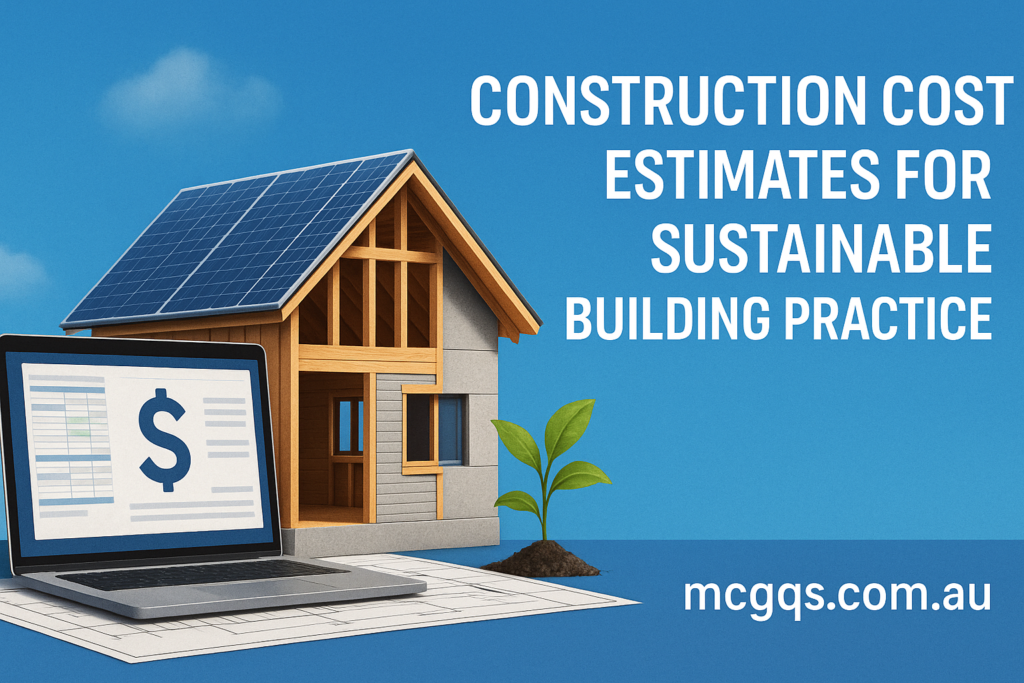Construction Cost Estimates for Sustainable Building Practices

In today’s age, the clarion call for sustainability resonates across industries. The construction sector, responsible for a significant chunk of global emissions and resource consumption, is no exception. Integrating sustainable practices into construction not only reduces the environmental footprint but often offers long-term cost savings. However, the initial investment required can be a matter of concern for many. This post sheds light on the cost estimates associated with sustainable building practices.
1. The Green Foundation
Sustainable construction typically begins below ground level. Using eco-friendly foundations like insulated concrete forms or rammed earth can decrease energy loss and create a robust, thermally efficient base.
Cost Implication: Initial costs might be higher than traditional methods, but reduced energy bills can balance out the investment over time.
2. Structural Materials: Reuse, Recycle, and Reduce
Sustainable construction prioritizes recycled, reclaimed, and regional materials. Whether it’s reclaimed wood, recycled steel, or locally sourced stones, these materials reduce the carbon footprint associated with transportation and new resource extraction.
Cost Implication: Recycled materials might cost more upfront, but their longevity and reduced environmental impact can justify the expense.
3. Green Roofs and Walls
Green or ‘living’ roofs and walls incorporate vegetation, helping with insulation, stormwater management, and biodiversity promotion.
Cost Implication: While green roofs might demand a higher initial investment compared to conventional roofs, they can extend roof lifespan and reduce energy costs.
4. Energy-efficient Windows and Doors
Double or triple-glazed windows, and tightly-sealed doors can massively cut down on energy consumption by preventing heat loss.
Cost Implication: These features might be pricier than their standard counterparts, but the savings in energy bills typically recoup the investment in a few years.
5. Solar Power Integration
Harnessing solar energy through panels or solar tiles reduces dependence on grid electricity, curbing greenhouse gas emissions.
Cost Implication: Solar installations can be a significant initial expense. However, with tax incentives, decreasing solar equipment costs, and long-term energy savings, the Return On Investment becomes evident.
6. Efficient Water Systems
Incorporating water-efficient plumbing systems, rainwater harvesting, and greywater recycling can lead to substantial water savings.
Cost Implication: The initial setup for these systems might be costly, but they can lead to decreased water bills and reduce the strain on local water resources.
7. Sustainable Insulation
Materials like wool, cellulose, or recycled denim offer effective insulation, reducing energy consumption and providing a healthier indoor environment.
Cost Implication: While sustainable insulation materials might carry a higher price tag, they offer superior performance and lifespan, leading to long-term savings.
8. Smart Building Systems
Integrating smart thermostats, energy-efficient lighting, and automated systems can optimize energy use, ensuring minimal waste.
Cost Implication: Smart systems come with higher upfront costs. Yet, their ability to streamline energy use can lead to considerable long-term savings.
9. Sustainable Landscaping
Using native plants, optimizing shade, and incorporating permeable paving can enhance building sustainability, reduce water use, and mitigate heat island effects.
Cost Implication: While initial landscaping costs might be comparable to conventional methods, reduced maintenance and watering needs can result in long-term savings.
10. Indoor Air Quality Enhancement
Using low-VOC paints, sealants, and materials ensures a healthier indoor environment, enhancing occupant well-being.
Cost Implication: Products prioritizing indoor air quality might have a slightly higher price point, but the health benefits they confer are invaluable.
Conclusion:
Sustainable building practices, while sometimes demanding a higher initial investment, underscore the adage, “You get what you pay for.” The upfront costs are often balanced out, if not surpassed, by long-term savings, durability, and the undeniable environmental and health benefits.
As sustainable construction becomes the norm rather than the exception, economies of scale will likely make these practices even more affordable. Those venturing into green construction today aren’t just investing in their projects; they’re investing in the future of our planet.
For construction professionals, homeowners, and investors, it’s vital to view sustainable building costs not as expenses but as investments. Investments that promise not just financial returns, but also a safer, healthier, and more sustainable world for generations to come.
